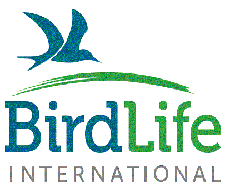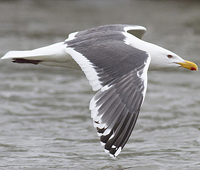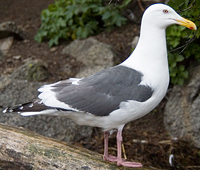 Slaty-backed Gull (schistisagus) / オオセグロカモメ / 큰재갈매기
Slaty-backed Gull (schistisagus) / オオセグロカモメ / 큰재갈매기
(last update: December 2015)
Slaty-backed Gull (schistisagus) adult June
BirdLife International Factsheet
 Justification
Justification
This species has a very large range, and hence does not approach the thresholds for Vulnerable under the range size criterion (Extent of Occurrence <20,000 km2 combined with a declining or fluctuating range size, habitat extent/quality, or population size and a small number of locations or severe fragmentation). The population trend is not known, but the population is not believed to be decreasing sufficiently rapidly to approach the thresholds under the population trend criterion (>30% decline over ten years or three generations). The population size may be moderately small to large, but it is not believed to approach the thresholds for Vulnerable under the population size criterion (<10,000 mature individuals with a continuing decline estimated to be >10% in ten years or three generations, or with a specified population structure). For these reasons the species is evaluated as Least Concern.
Taxonomic source(s)
del Hoyo, J.; Collar, N. J.; Christie, D. A.; Elliott, A.; Fishpool, L. D. C. 2014. HBW and BirdLife International Illustrated Checklist of the Birds of the World. Barcelona, Spain and Cambridge UK: Lynx Edicions and BirdLife International.
Distribution and population
The Slaty-backed Gull breeds in north-east Siberia (Russia) from Cape Navarin south to the northern tip of North Korea, including the Commander Islands, Russia and Hokkaido, Japan. Its winter distribution extends south to encompass Korea, the extreme north-east of China, much of Japan and Taiwan (del Hoyo et al. 1996).
Population justification
The global population is estimated to number c.25,000-1,000,000 individuals (Wetlands International 2006), while national population estimates include: c.50-10,000 wintering individuals in China; c.50-10,000 wintering individuals in Korea; c.10,000-100,000 breeding pairs and > c.1,000 wintering individuals in Japan and c.10,000-1 million breeding pairs and > c.1,000 individuals on migration in Russia (Brazil 2009).
Trend justification
The population trend is difficult to determine because of uncertainty over the extent of threats to the species (del Hoyo et al. 1996).
Ecology
This species can be found over inshore coastal waters. Its diet varies year to year depending on availability, mainly consisting of fish and invertebrates (e.g. crabs, sea urchins) but also carrion, refuse, offal, bird eggs and chicks, voles and insects. Birds may also take fish and roe during salmon spawning, leftovers from bear-kills, berries, and waste from fisheries and slaughterhouses. Some Hokkaido males specialise on predation, piracy and scavenging from seabird colonies but they feed their chicks mostly on fish. Prey is obtained by a varied of methods including plunge-diving and surface-plunging. Birds arrive at breeding colonies in April in the south and June in the north. Colonies form on low sea cliffs, rocky islets, sandy shores or the rocky tops of sea cliffs and can number from dozens to 1500 pairs. Many populations are non-migratory (del Hoyo et al. 1996).
References
Brazil, M. 2009. Birds of East Asia: eastern China, Taiwan, Korea, Japan, eastern Russia. Christopher Helm, London.
del Hoyo, J.; Elliott, A.; Sargatal, J. 1996. Handbook of the Birds of the World, vol. 3: Hoatzin to Auks. Lynx Edicions, Barcelona, Spain.
Delany, S.; Scott, D. 2006. Waterbird population estimates. Wetlands International, Wageningen, The Netherlands.
Further web sources of information
Explore HBW Alive for further information on this species
Search for photos and videos, and hear sounds of this species from the Internet Bird Collection
Text account compilers
Ekstrom, J., Butchart, S., Calvert, R.
IUCN Red List evaluators
Butchart, S., Symes, A.
Recommended citation
BirdLife International (2015) Species factsheet: Larus schistisagus. Downloaded from http://www.birdlife.org on 20/11/2015. Recommended citation for factsheets for more than one species: BirdLife International (2015) IUCN Red List for birds. Downloaded from http://www.birdlife.org on 20/11/2015.
This information is based upon, and updates, the information published in BirdLife International (2000) Threatened birds of the world. Barcelona and Cambridge, UK: Lynx Edicions and BirdLife International, BirdLife International (2004) Threatened birds of the world 2004 CD-ROM and BirdLife International (2008) Threatened birds of the world 2008 CD-ROM. These sources provide the information for species accounts for the birds on the IUCN Red List.
To provide new information to update this factsheet or to correct any errors, please email BirdLife
To contribute to discussions on the evaluation of the IUCN Red List status of Globally Threatened Birds, please visit BirdLife's Globally Threatened Bird Forums.
 Slaty-backed Gull (schistisagus) adult, June 21 2013, Kamchatka / Chukotka Coast, Russia. Picture: Benjamin van Doren.
Slaty-backed Gull (schistisagus) adult, June 21 2013, Kamchatka / Chukotka Coast, Russia. Picture: Benjamin van Doren. Slaty-backed Gull (schistisagus) adult, June 2008, Magadan, Magadan Oblast, Russia. Picture: A.V. Andreev.
Slaty-backed Gull (schistisagus) adult, June 2008, Magadan, Magadan Oblast, Russia. Picture: A.V. Andreev.